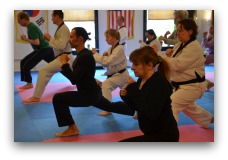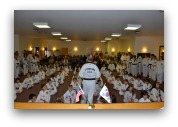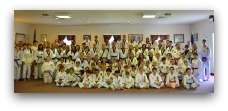Not Everything Needs a Ball
Not long ago, my wife was speaking with the
editor of our local newspaper regarding a recently submitted press release describing
a public-service event hosted by the Chosun Taekwondo Academy Leadership Team,
a group of young individuals who routinely engage in elevated training, provide
community service on a regular basis, and utilize the virtues of tae kwon do as
a vehicle to promote leadership skills.
During the course of the
conversation, the editor praised the group for their tireless efforts in
assisting the underprivileged and further recognized the fact that this was not
the first time he had received such a bulletin publicizing our outreach
program. Additionally, he was quick to note that local community leaders and
citizens in concert take heed of the good deeds propagated by our students, all
done with a minimum of fanfare.
Then the conversation took an
interesting turn. While not coming out directly and saying so, he juxtaposed
our group against various sports teams in the area whose primary mission is to
dominate on the playing fields often at the cost of the very virtues supported
by traditional tae kwon do training. While these entities often strive to
stimulate charitable contributions as well, they do so obliquely without
recognizing the noble engine that drives the process of compassion, and thus philanthropy,
albeit in a benign manner. He then went on to summarize this notion by uttering
the phrase “not everything needs a ball”. Given the huge popularity of varsity
sports and the attention they are given by the local press, I was astonished by
his comment.
At this point, I should
mention that I personally have never been a sports enthusiast and, in truth,
find many of the emotions elicited by such pastimes distasteful at best. By way
of example, whether it be taekwondo as a sport, football or little league
baseball, the unbridled actions of overzealous parents in distorted support of
their offspring during the competitive process, frequently borders on riotous
conduct. This atmosphere of behavior is not what we are attempting to cultivate
in the traditional martial arts and to hear a man of erudition encapsulate this
concept so succinctly was heartwarming indeed.
I am certain many readers will
take exception with my point of view; especially those with children who
participate in a variety of extra-curricular activities including those
mentioned above. But it is the heritage of the Korean martial arts that stimulates
the concept of giving back to ones community just as the ancient Hwarang
warriors did when not occupied by battle. In my opinion, tae kwon do training undeniably
represents nobility in motion. Every class is tempered with courtesy, humility,
compassion and purpose. And for youngsters whose minds and hearts are uniquely
open to suggestion, this is paramount.
Quite naturally, those unfamiliar
with the discipline will argue, and understandably so, that tae kwon do
resonates with aggression and violence, offering no socially-redeeming
qualities whatsoever. And on the surface, this may be true. But if one were to
take a closer look under the hood, milestones in the elevation of character
will be revealed…all this minus the competitive mindset and barely masked hostility,
often fostered under the guise of team sports.
As instructors of tae kwon
do, we frequently say that “the only person you are competing against is
yourself.” And for the most part, this is accurate effectively removing it from
the fundamental doctrines of sport. Practitioners, of any age, sincerely
seeking an enhanced lifestyle gradually alter longstanding habits of a questionable
nature in favor of those that bolster integrity, compassion and discipline;
traits that go hand in hand with cultivating an empathic worldview. Upon closer
investigation, we see the long shadow cast by Confucianism on this process.
Since traditional tae kwon do is influenced by the three Asian philosophical
paradigms including Taoism, Buddhism and Confucianism, this is understandable.
Confucius, or more correctly
K’ung Fu-tzu, espoused the cultivation of the “superior man”, one who is aware
of his or her unique place in, and responsibility to, society at large. Furthermore,
he taught that a single individual can influence world events through the
simple projection of a benevolent state of mind. The Korean proverb, su shin je ga chi guk pyong chun fa, supports
this philosophy. Loosely translated, this dictum states that, “peace within the
individual brings peace within the family; peace in the family brings peace in
the community; peace in the community, peace in the country and, ultimately,
peace throughout the world.” As improbable as this may sound, there is little
doubt that compassion towards fellow human beings goes a long way. Rather than
being isolated in a vacuum, correct action ripples across humanity with much
the same effect as would a pebble when dropped into a serene pool of water. Following
this path leads the individual to develop a sense of purpose and harmony within
the community.
Moreover, it should be
remembered that the martial arts of the 21st century are
significantly different from those practiced centuries ago. While self-defense
remains the core purpose of practice, enrichment of character has evolved as a
central theme as well. This metamorphosis began during the late 19th
century with the creation of disciplines such as judo and karate-do by Gigoro
Kano and Gichen Funakoshi respectfully. Martial arts intended to sustain a
warrior on the field of battle became martial ways, or do, with the added benefit of building physical fitness,
nationalism and morality in youngsters and college students alike. For the most
part, with the exception of combat sport and MMA, this concept continues on
today as the standard model in contemporary martial arts education. From this, it
is not difficult to perceive the connection between a desire to improve the
lives of others through community outreach and the virtuous tenets of
traditional tae kwon do including courtesy, integrity, perseverance,
self-control and indomitable spirit.
Lastly, while sport and all
its trappings can provide an outlet for aggression and create social bonds by
way of teambuilding, they all, by definition, are restricted to a set place and
time. Meanwhile, the robust philosophical foundation that acted as a code of
honor for the Hwarang continues to support traditional tae kwon do in the new
millennium and remains as valid today as it was in the seventh century when
these noble warriors sought moral wisdom beyond the zone of combat.
Ultimately, the modern martial artist, of
whatever age, should not only be physically fit and adroit in the ways of
self-defense, but in addition, become a beacon of strength and courage for
family, friends and those less fortunate than he or she. By extension,
enriching ones community through programs of systematic outreach, particularly
by young practitioners, proves beyond a doubt that “not everything needs a
ball” to provide a sense of self-worth coupled with community spirit. The
above, amplified by an element of self-respect, is what it means to be a true
modern day warrior clad in the armor of virtuous action, tailored by a earnest
study of traditional tae kwon do.














